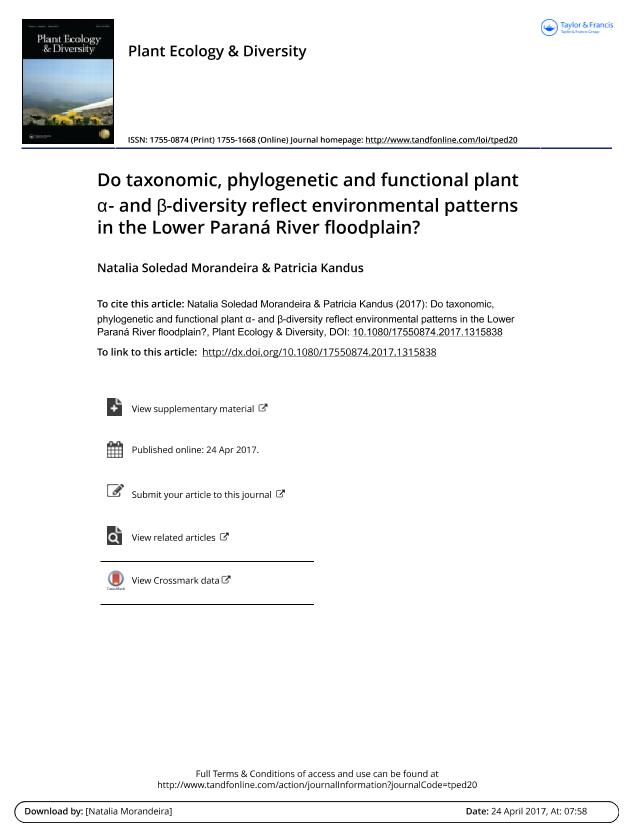Mostrar el registro sencillo del ítem
dc.contributor.author
Morandeira, Natalia Soledad

dc.contributor.author
Kandus, Patricia

dc.date.available
2018-04-04T16:11:00Z
dc.date.issued
2017-04
dc.identifier.citation
Morandeira, Natalia Soledad; Kandus, Patricia; Do taxonomic, phylogenetic and functional plant α- and β-diversity reflect environmental patterns in the Lower Paraná River floodplain?; Taylor & Francis Ltd; Plant Ecology & Diversity; 10; 2-3; 4-2017; 1-13
dc.identifier.issn
1755-0874
dc.identifier.uri
http://hdl.handle.net/11336/40701
dc.description.abstract
Background: Floodplain wetlands feature high plant biodiversity, comprising variability in several organisation levels and at different scales. Aims: In a large river floodplain, we aimed to answer whether taxonomic, phylogenetic and functional α-diversity of herbaceous assemblages responded to hydrogeomorphic features conditioning the local flood pulse and/or to soil features; and to determine the relationship between β-diversity and geographic and environmental distances. Methods: Taxonomic, phylogenetic and functional α-diversity indices were computed in 82 sites in the Lower Paraná River floodplain. Relationships between α-diversity and environment were explored by generalised linear models. Spatial structure was assessed by semi-variograms. Responses of partitions of β-diversity to geographic or environmental distances were tested through multiple regressions in distance matrices. Results: Taxonomic and phylogenetic α-diversity showed a similar pattern in relation to environment, especially to hydrogeomorphic features. The regression model fitted to species richness had the highest explanatory power. Regarding functional α-diversity, only the number of plant functional types responded to environmental features. Partitions of β-diversity, particularly the replacement of functional strategies, were better explained by environmental than by geographic distances. Conclusions: The diversity patterns of plant assemblages in a large river floodplain highlight the importance of heterogeneity conditioning the local effect of flood pulse regimes.
dc.format
application/pdf
dc.language.iso
eng
dc.publisher
Taylor & Francis Ltd

dc.rights
info:eu-repo/semantics/openAccess
dc.rights.uri
https://creativecommons.org/licenses/by-nc-sa/2.5/ar/
dc.subject
Autocorrelation
dc.subject
Floodplain Wetlands
dc.subject
Generalised Linear Models
dc.subject
Macrophytes
dc.subject
Wetland Ecology
dc.subject.classification
Otras Ciencias Biológicas

dc.subject.classification
Ciencias Biológicas

dc.subject.classification
CIENCIAS NATURALES Y EXACTAS

dc.title
Do taxonomic, phylogenetic and functional plant α- and β-diversity reflect environmental patterns in the Lower Paraná River floodplain?
dc.type
info:eu-repo/semantics/article
dc.type
info:ar-repo/semantics/artículo
dc.type
info:eu-repo/semantics/publishedVersion
dc.date.updated
2018-04-04T14:20:31Z
dc.identifier.eissn
1755-1668
dc.journal.volume
10
dc.journal.number
2-3
dc.journal.pagination
1-13
dc.journal.pais
Reino Unido

dc.journal.ciudad
Londres
dc.description.fil
Fil: Morandeira, Natalia Soledad. Universidad Nacional de San Martín. Instituto de Investigación e Ingeniería Ambiental. Laboratorio de Ecología, Teledetección y Ecoinformática; Argentina. Consejo Nacional de Investigaciones Científicas y Técnicas; Argentina
dc.description.fil
Fil: Kandus, Patricia. Consejo Nacional de Investigaciones Científicas y Técnicas; Argentina. Universidad Nacional de San Martín. Instituto de Investigación e Ingeniería Ambiental. Laboratorio de Ecología, Teledetección y Ecoinformática; Argentina
dc.journal.title
Plant Ecology & Diversity

dc.relation.alternativeid
info:eu-repo/semantics/altIdentifier/doi/http://dx.doi.org/10.1080/17550874.2017.1315838
dc.relation.alternativeid
info:eu-repo/semantics/altIdentifier/url/https://www.tandfonline.com/doi/full/10.1080/17550874.2017.1315838
Archivos asociados
